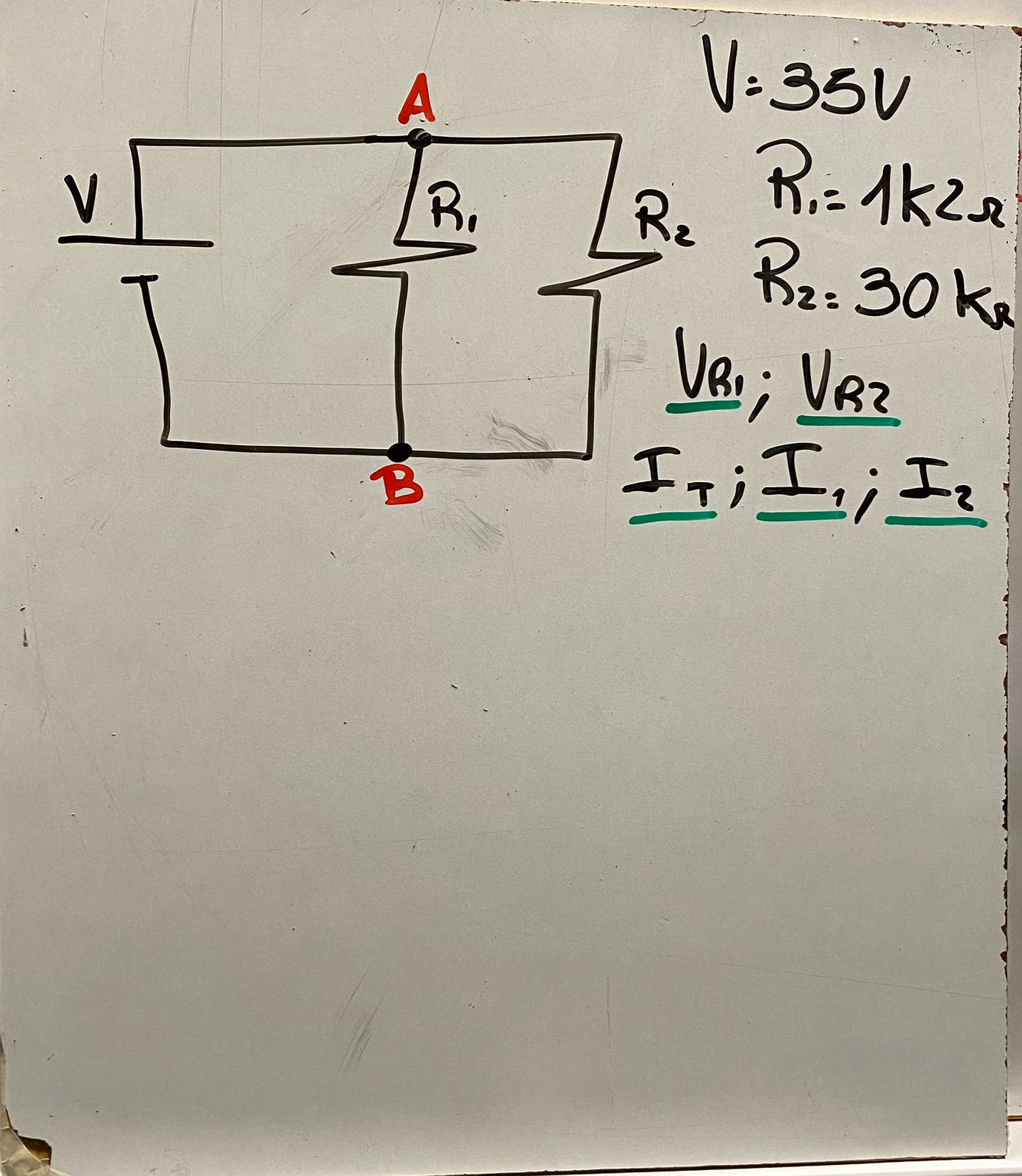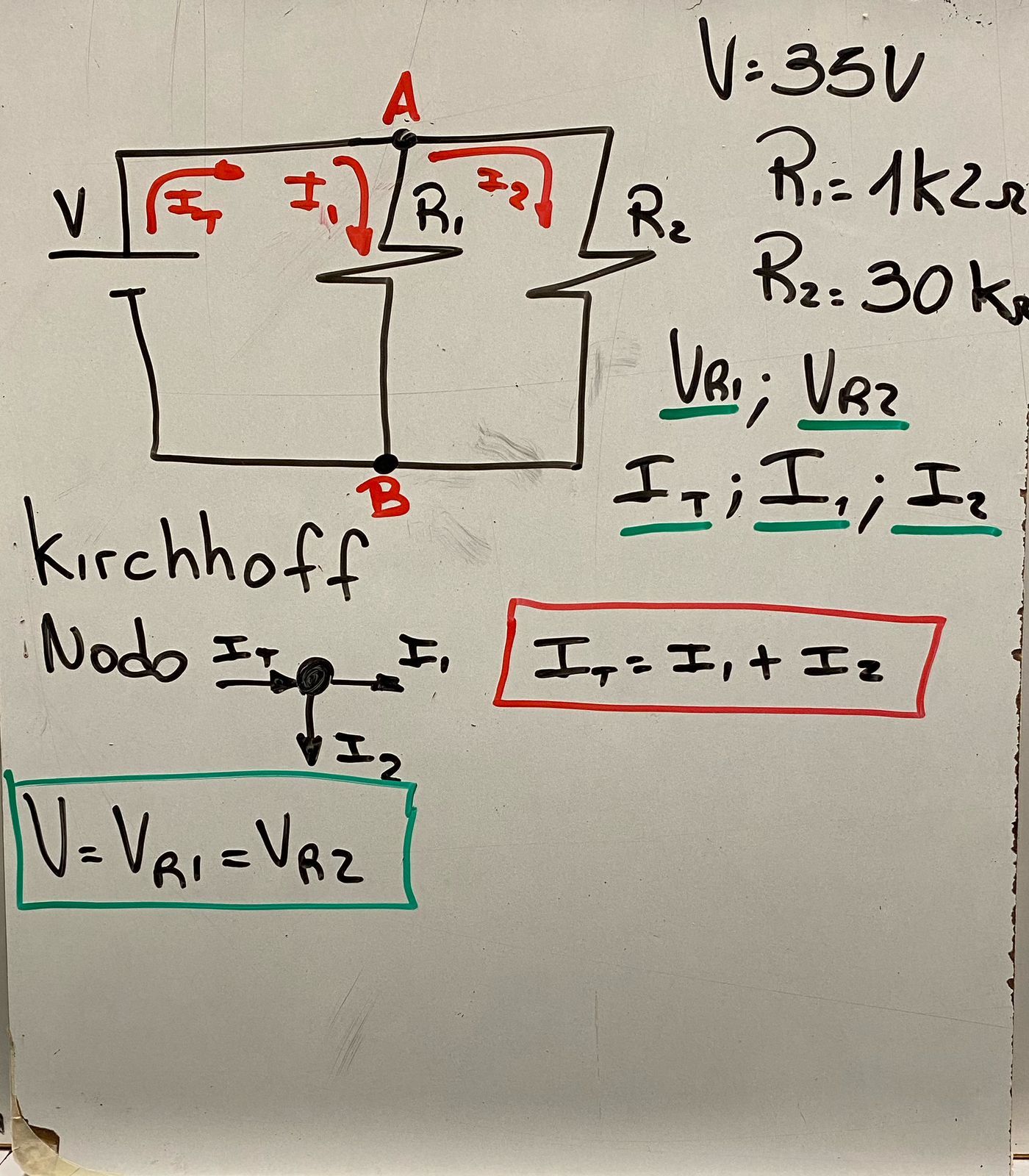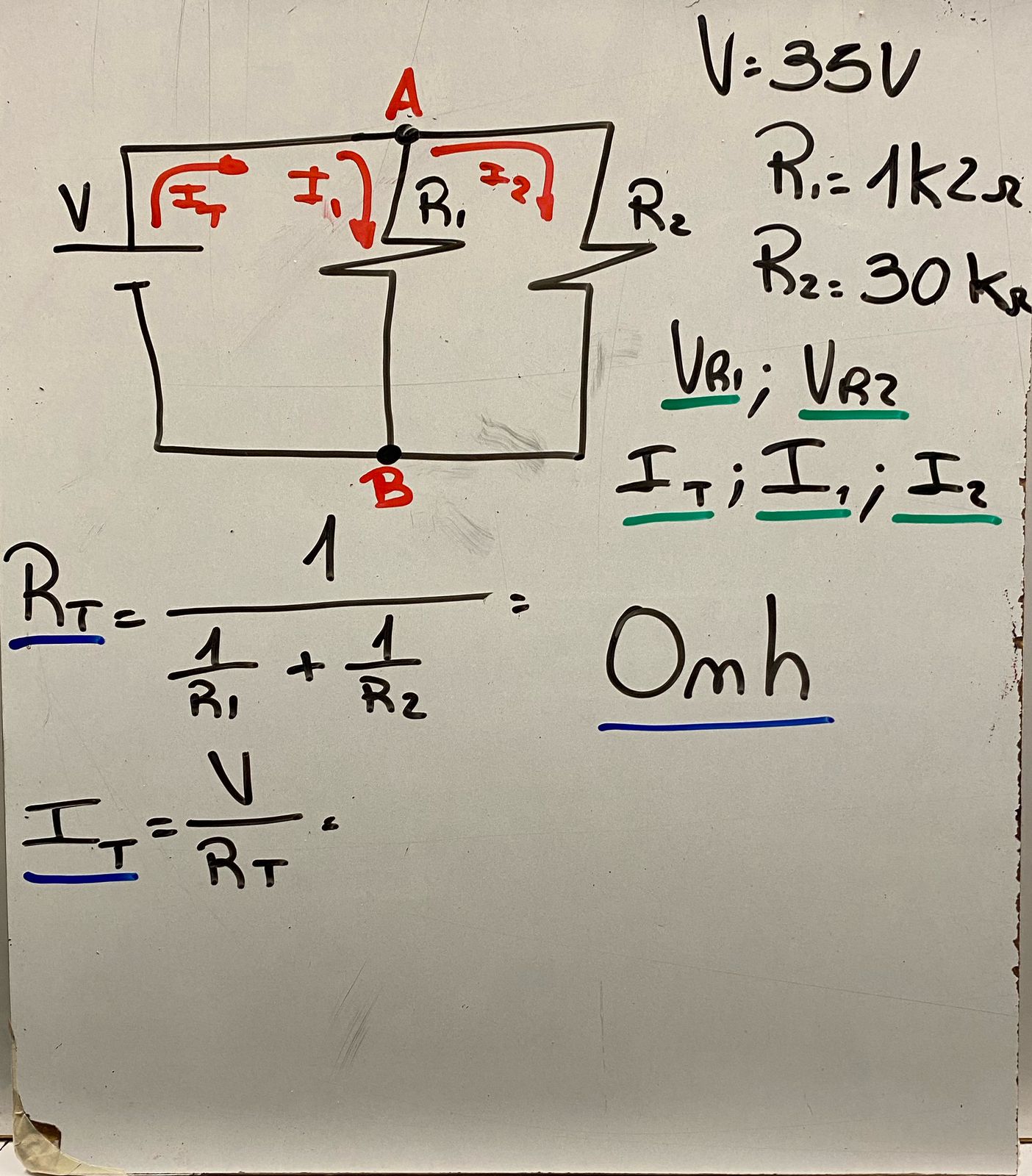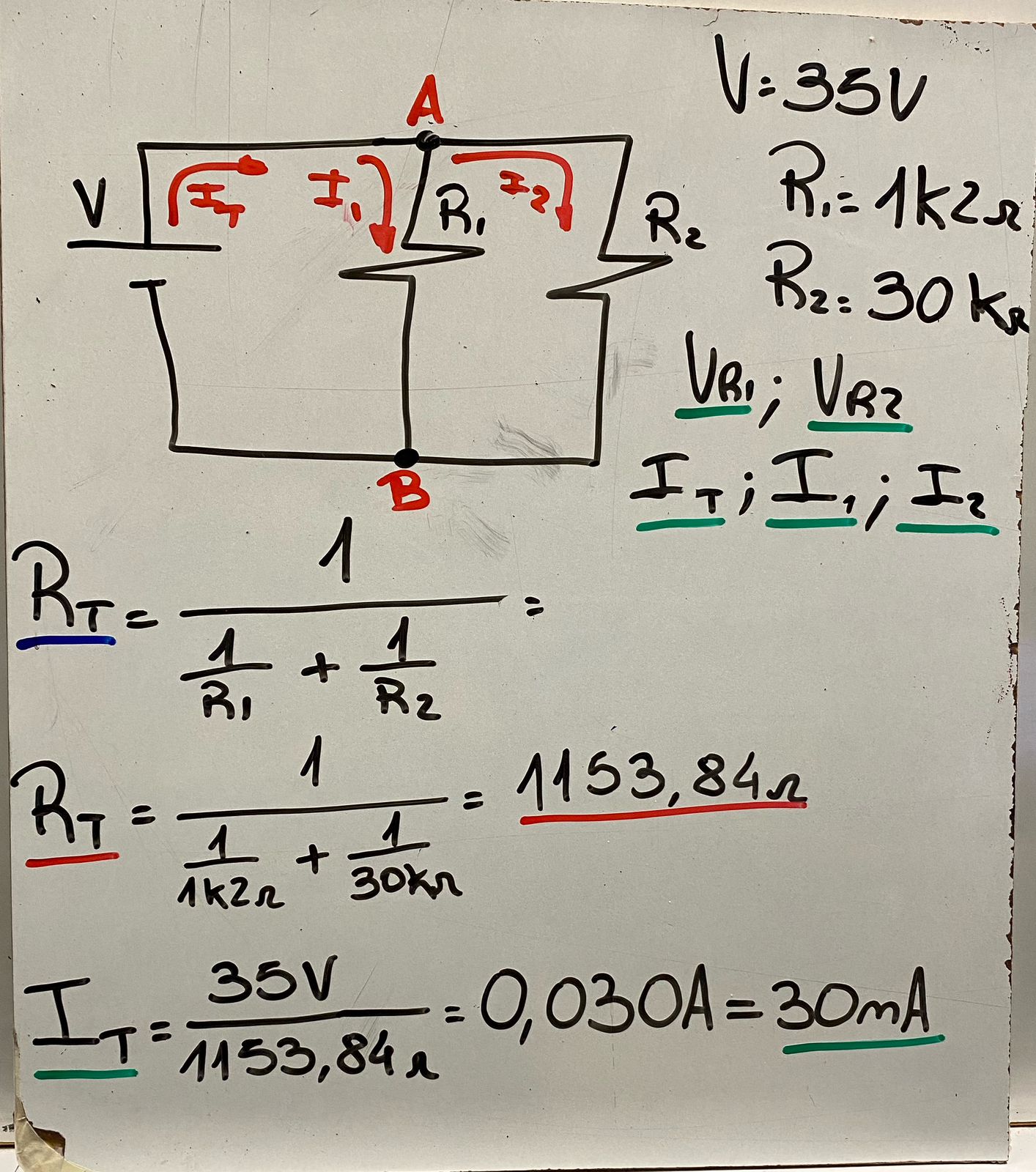[ESP]
¡Hola amigos de Hive!
Después de resolver el ejercicio anterior sobre resistencias en serie usando las leyes de Ohm y Kirchhoff, hoy nos toca un nuevo reto. Vamos a ver cómo resolver un circuito paralelo con dos resistencias, aplicando las mismas leyes y viendo qué conclusiones sacamos de los resultados.
En la próxima imagen, les dejo el circuito a analizar. El objetivo es hallar las caídas de tensión en el circuito y las corrientes en cada rama ¡Acompáñenme y descubramos juntos este nuevo desafío!
En el circuito de la imagen anterior, las resistencias están conectadas de manera que la corriente puede fluir por varios caminos. En este caso, tenemos dos resistencias: una de 1K2 ohms y otra de 30K ohms. Esto significa que ambas están conectadas a la misma fuente de voltaje, pero la corriente se divide entre ellas.
Lo interesante de un circuito paralelo es que el voltaje a través de cada resistencia es el mismo, pero la corriente que pasa por cada una es diferente. Como la resistencia de 30K ohms es mucho mayor que la de 1K2 ohms, la corriente que pasara por la resistencia de 30K ohms será menor que la que pase por la de 1K2 ohms.
Entonces podemos deducir lo sigueinte:
Después de deducir estas dos ecuaciones usando las leyes que estamos practicando, ahora podemos avanzar y plantear las fórmulas para resolver las incógnitas restantes. Esto nos permitirá comenzar a abordar la consigna y descubrir las respuestas que buscamos
Según la ley de Ohm, lo primero es calcular la resistencia total del circuito para poder empezar con la tarea de hoy: encontrar la corriente total y analizar el circuito en detalle. Vamos a reemplazar algunos valores para que sea más claro.
Habiendo obtenido el valor de la resistecia total del circuito, pudimos calcular la corriente total del mismo, esto nos habilita para poder calcular la ramificacion de esta correinte en las dos resistencias del circuito.
Una vez que calculemos las corrientes en las dos ramas del circuito, vamos a verificar los resultados aplicando la ley de Kirchhoff. Además, veremos cómo se cumplen estas leyes a la perfección.
De esta forma, podemos ver la utilidad práctica de estas leyes en los circuitos paralelos de resistencias y aprender cómo aplicarlas en situaciones reales. En futuros ejercicios, exploraremos circuitos más complejos con múltiples componentes para entender cómo interactúan en conjunto, aplicando todo nuestro conocimiento hasta ahora. Los invito a practicar estos ejercicios y compartir sus preguntas y descubrimientos en los comentarios para seguir aprendiendo juntos. ¡Espero con ansias ver sus progresos!
Respuestas del ejercicio
Rt: 769.23 Ohms It: 78mA ; Ir1: 12mA ; Ir2: 60mA ; Ir3: 6mA
[ENG]
Hello Hive friends!
After solving the previous exercise on series resistors using Ohm and Kirchhoff's laws, today we have a new challenge. We are going to see how to solve a parallel circuit with two resistors, applying the same laws and seeing what conclusions we draw from the results.
In the next image, I leave you the circuit to analyze. The objective is to find the voltage drops in the circuit and the currents in each branch. Join me and let's discover this new challenge together!
In the circuit shown above, the resistors are connected so that current can flow through multiple paths. In this case, we have two resistors: one of 1K2 ohms and another of 30K ohms. This means that both are connected to the same voltage source, but the current is divided between them.
The interesting thing about a parallel circuit is that the voltage across each resistor is the same, but the current passing through each one is different. Since the 30K ohm resistor is much larger than the 1K2 ohm resistor, the current that will pass through the 30K ohm resistor will be less than the current that will pass through the 1K2 ohm resistor.
Then we can deduce the following:
After deducing these two equations using the laws we are practicing, we can now move forward and propose the formulas to solve the remaining unknowns. This will allow us to begin to address the question and discover the answers we are looking for.
According to Ohm's law, the first thing is to calculate the total resistance of the circuit so that we can start with today's task: find the total current and analyze the circuit in detail. Let's replace some values
to make it clearer.
Having obtained the value of the total resistance of the circuit, we were able to calculate its total current, this enables us to calculate the branching of this current in the two resistances of the circuit.
Once we calculate the currents in the two branches of the circuit, we will verify the results by applying Kirchhoff's law. Furthermore, we will see how these laws are perfectly fulfilled.
In this way, we can see the practical usefulness of these laws in parallel resistance circuits and learn how to apply them in real situations. In future exercises, we will explore more complex circuits with multiple components to understand how they interact together, applying all of our knowledge so far. I invite you to practice these exercises and share your questions and discoveries in the comments to continue learning together. I look forward to seeing your progress!
Exercise answers
Rt: 769.23 Ohms It: 78mA ; Ir1: 12mA ; Ir2: 60mA ; Ir3: 6mA






Greetings @profwhitetower ,
Excellent post...appreciate the English translation and the diagram illustrations...thank you!
Caio/Cheers!
Greetings @bleujay ,
Thank you very much for your kind words! I'm glad to hear that you found the English translation and illustrations of the diagram helpful. Thanks for your support!
@profwhitetower
Thanks for your contribution to the STEMsocial community. Feel free to join us on discord to get to know the rest of us!
Please consider delegating to the @stemsocial account (85% of the curation rewards are returned).
You may also include @stemsocial as a beneficiary of the rewards of this post to get a stronger support.
Gracias por el apoyo🫶🏻
Congratulations @profwhitetower! You have completed the following achievement on the Hive blockchain And have been rewarded with New badge(s)
Your next target is to reach 800 upvotes.
You can view your badges on your board and compare yourself to others in the Ranking
If you no longer want to receive notifications, reply to this comment with the word
STOP